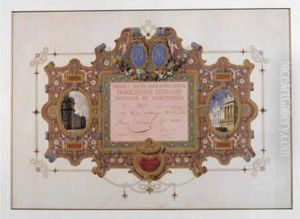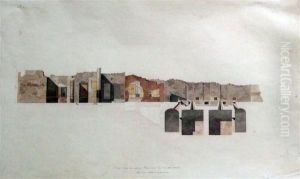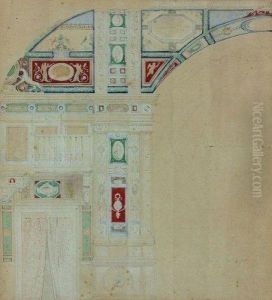Felix Duban Paintings
Félix Duban was a French architect, born in Paris on October 14, 1798. He was a prominent figure in the architectural movement of the 19th century, particularly associated with the Ecole des Beaux-Arts, where he was a professor and an influential instructor. Duban is best known for his colorful and eclectic restorations of French Renaissance architecture, and his work epitomized the Romantic spirit of his time, celebrating historical styles with an imaginative and sometimes inventive approach.
Duban's education at the Ecole des Beaux-Arts was under the tutelage of prominent architects such as Antoine-Laurent-Thomas Vaudoyer and Louis-Hippolyte Lebas. His talent was recognized early on when he won the prestigious Prix de Rome in 1823, which afforded him the opportunity to study in Italy at the French Academy in Rome, the Villa Medici. His time in Italy deeply influenced his architectural style, as he developed a strong appreciation for the colors and details of Renaissance and ancient buildings.
Upon his return to France, Duban embarked on a series of significant projects, one of the most notable being the grand restoration of the Château de Blois, a French royal residence. His restoration work, which began in 1845, aimed to revive the chateau's former glory, drawing upon a mix of authentic elements and Duban's own interpretations of the Renaissance style. He also worked on the restoration of parts of the Fontainebleau Palace.
In Paris, Duban's work includes contributions to the Ecole des Beaux-Arts building itself, where his design for the main façade, completed in 1861, is celebrated for its harmonious integration with the older structures. His other works in the city include the completion of the Palais des Études and the Court of Cassation at the Palais de Justice.
As an educator, Duban was instrumental in shaping the curriculum and teaching methods at the Ecole des Beaux-Arts, influencing a generation of architects who would go on to define the Beaux-Arts architectural style, which became dominant in the late 19th and early 20th centuries, especially in the United States.
Félix Duban's architectural philosophy was characterized by a respect for historical accuracy combined with a creative reinterpretation that often incorporated modern needs and sensibilities. His legacy is not only found in the buildings he designed and restored but also in the impact he had on the education and practices of architects who followed him. Duban passed away on October 8, 1870, in Paris, leaving behind a rich architectural heritage that continues to be studied and admired.


